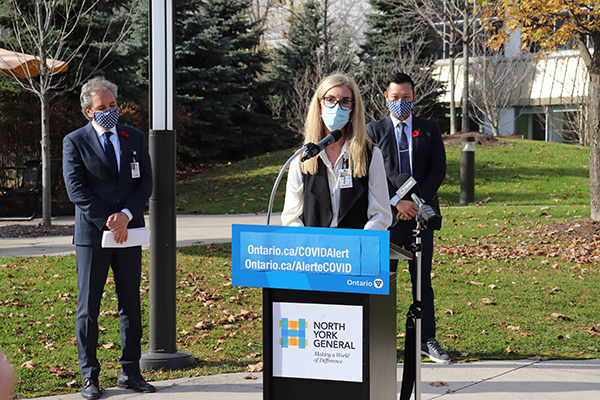Responding to community needs during the pandemic

COVID-19 is testing our health system like nothing we’ve experienced in generations. During the first wave of the pandemic we were able to successfully control the spread and limit the damage of the virus by working in partnership – as one health care team. And this is how we will fight this new disease during this formidable second wave.
One of the ways we are partnering is to support older adults and other people to receive care in their homes and communities while making hospital beds available for more patients, including those suffering from COVID-19.
In early November, the Ontario Government announced more than $3.5 million for North York General to support 40 transitional care beds and two critical care beds in the North York area. The transitional care beds are located in a local retirement home with Bayshore Home Health providing nursing and other health professional support to meet residents’ needs.
“The 40 new transitional care beds will mean that 40 more individuals will be able to transition to the community sooner for ongoing care, while making hospital beds available for patients who need them the most,” said Samuel Elfassy, Chair of the Board of Governors for North York General Hospital.
COVID-19 testing has been another monumental community effort.
Early in the pandemic, North York General was one of the first GTA hospitals to open an Assessment Centre to test for COVID-19. As COVID cases began to climb during the second wave, the demand for testing also increased dramatically, and our organization, like others across Ontario, expanded testing for those with symptoms and other risks and moved to an appointment-based system.
“The new testing structure allows us to ensure those who are experiencing symptoms receive tests in a timely manner, without having them wait in line outside an assessment centre,” says Marielle Freeman, Clinical Coordinator at the Branson Assessment Centre. “Before appointment-based testing was introduced, we were seeing long waits for testing due to unprecedented demand.”
In early October, Ontario introduced new testing guidelines and designated COVID-19 Assessment Centres only for people with symptoms associated with COVID-19 and risk factors such as having close contact with someone who has tested positive or living or working in a setting with an outbreak. Select pharmacies across Ontario offer appointment-based testing to people without symptoms.
When the demand for tests skyrocketed at the beginning of the school year, the goal quickly shifted to getting the growing wait times for tests under control. Organizations understood they needed to join forces to clear the backlog and ensure timely tests for people with symptoms – a key to preventing community transmission.
“Our teams have assisted with managing community spread in ways that stretch beyond our Assessment Centre walls. We have partnered with others in the community to enhance contact tracing, clear the backlog of test results, and increase capacity for testing both in our Shared Hospital Lab and Assessment Centre,” says Marielle.
The Shared Hospital Lab is a Toronto hospital partnership of North York General, Michael Garron Hospital, Sunnybrook Health Sciences Centre and Scarborough Health Network. As one of Ontario’s largest labs, the Shared Hospital Lab has rapidly ramped up testing volumes for Toronto while lending a hand to other Ontario labs to reduce testing wait times across the province. To date, the Shared Hospital Lab has completed more than 100,000 COVID tests – or between 3,000 and 6,500 tests per day.
“While we certainly see the bulk of demand from our Assessment Centre, our teams are providing support to more vulnerable populations who are in higher risk settings,” says Dr. Rebecca Stoller, a Family Physician with the North York Family Health Team and physician lead for the Branson COVID Assessment Centre.
Dr. Stoller is part of a team of community-based health care providers who are partnering to provide mobile testing to residents of long-term care homes and other congregate care settings.
“We have been working diligently to find innovative ways to serve our community and it’s not a one-size-fits-all approach. We have to be nimble and able to adapt to changing priorities, especially at a time when we’re starting to see both COVID and other respiratory viruses circulating locally,” says Dr. Stoller. “Our work is far from finished but we continue to explore more customized testing strategies, and innovative care models to support our community and alleviate the burden on our health care system.”
